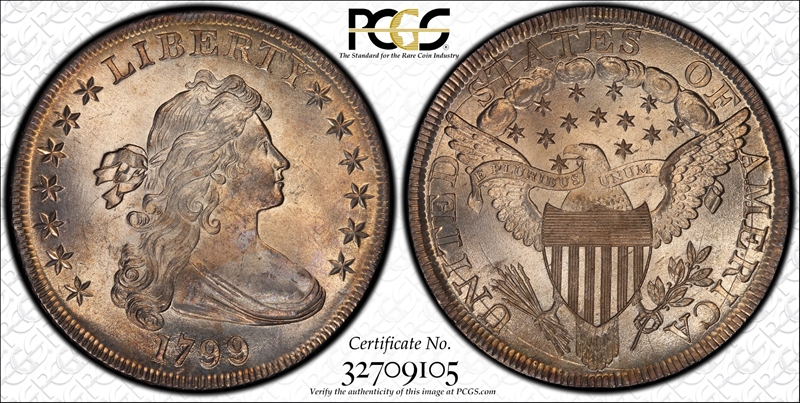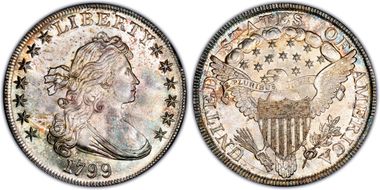1799 $1 BB-157 MS65+ 认证号-60273, PCGS号40049
专家评论
Q. David Bowers
The following narrative, with minor editing, is from my "Silver Dollars & Trade Dollars of the United States: A Complete Encyclopedia" (Wolfeboro, NH: Bowers and Merena Galleries, Inc., 1993). Note: the Notable Specimens list should be used with caution - it has been updated in my 2013 edition of "The Encyclopedia of United States Silver Dollars 1794-1804."Bolender-5, Haseltine-5
OBVERSE 4: See description under BB-156. In BB-157 and BB-162 the upper right corner is slightly indented in the 1 in date.
Obverse die used to strike 1799 BB-156 (with clash marks), BB-157, BB-161 (now relapped), BB-162, BB-163, and BB-164.
REVERSE H: U in UNITED imperfect at upper left, the vertical element being cut off at the upper left side, taking with it the upper left serif; a defective punch was employed (used on three different dies to strike BB-157; BB-158, BB-159, BB-160, and BB-161; and BB-168). Leaf points almost under left side of upright of I in AMERICA. All six upper stars touch clouds, the two on right each having two points touching, and other four have one point touching (the star that is below clouds 2-3 nearly touches 3). Far right edge of A is over junction of clouds 3 and 4. Point of star touches point of lower part of eagle's beak; ray points directly to center of left upright of U in PLURIBUS. A touches third feather.
The reverse is similar to the die used to coin BB-158 (later, BB-159, BB-160, and BB-161), a die which must have been made about the same time, but can be easily distinguished. On BB-157, the two upper stars on the right have two points which touch clouds 7 and 8. On BB-158, etc., the upper right star has only one point which touches cloud 8.
Reverse die used to strike 1799 BB-157 only.
DIE STATES:
Die State I: Obverse die without crack. Reverse die without crack. May not exist without reverse crack.
Die State II: Bolender-5a. Obverse as preceding. Reverse with hairline crack beginning below stem, progressing to the left through the tip of the eagle's tail, UNITED, wing tip, and STA; then as the die crack continues (on slightly later states) it goes to T, then to E, the top of S, and the border. The last named is the die state usually seen.
Die State III: Obverse as preceding. Reverse with additional cracks: Crack through bottom part of AT, below E, to top of cloud 5. Crack through AMER. Frequently seen die state.
Die State IV: Obverse as preceding. Reverse now with earlier crack through AMER now extending through IC. Crack from border, through upright of T, through cloud 2, curving left to touch star below cloud 1. The latest reverse die state seen. Scarce.
Note: Bolender said Bolender-5a has "short die cracks from lower left corner of E down to hair, and below first star." I have not seen this obverse crack on any die state of BB-157.
COLLECTING NOTES: 1799 BB-157 is one of the most plentiful issues of the year. About 650 to 1,000 are extant today. Despite this relative abundance, nearly all specimens are in circulated grades through VF, with a scattering of EF pieces as well. Higher grade pieces are few and far between. However, among those scattered high-grade gems are a few in the MS-63 to 65 echelons, suggesting the original existence of a small hoard of this variety, long since dispersed.
NOTABLE SPECIMENS:
October Sale Specimen. MS-65 (NGC). Superior, October Sale,1990: 3716. "Superb! Silvery gray and iridescent blue color, flashy mint lustre underneath its toning; immaculate surfaces."
May Sale Specimen. MS-64 (PCGS). Superior, May Sale, 1991:951. "Razor-sharp features of Liberty and the eagle as well as its smooth satiny lustre."
Kagin Specimen. MS-60. Kagin's, November 1987:3245. "Lovely, steel green and gray toned specimen with tremendous strike and fantastic appearance. With a 10x glass we do detect some very light scratches and roughness on Liberty's face and neck. All of the stars are very sharp as are the feathers of the reverse eagle. Much mint lustre of a satiny imparting a gentle glow to this specimen."
Robison Specimen. MS-60. Stack's, Spring Sale, April 1978:717. Stack's, Ellis H. Robison Collection, 1982: 1870. "Brilliant Unc. Full frosty lustre with lovely golden and pale iridescent toning. The barest touch of friction on the high points but really superb."
Davis Specimen. AU-58. Davis-Graves Games Davis) Collection (Stack's, 1954): Mint State (with friction: called AU-58 ill the Condition Census below).
Anderson-Dupont Specimen. AU-58. Stack's, Anderson-Dupont Collection, 1954:2503. "Unc., trace of friction on eagle’s breast, and two tiny nicks on drapery. Adjustment marks through LIBERTY. Exceptional condition."
Shore Specimen. AU-58. Superior, A. Bernard Shore Collection, 1988:2210. "Extremely well struck with detail of a fully Mint State coin. Retoned in an attempt to hide concentrated scratches on the obverse and reverse."
Hollinbeck-Kagin Specimen. AU-55. Hollinbeck-Kagin Sale, March 1970:672. "Bluish golden Unc. but close inspection reveals slight rubbing (old-time cabinet friction).". Hollinbeck-Kagin Sale. June 1970: 621. "Unc, with lovely bluish golden prooflike patina, careful examination with a strong glass reveals a faint mint-equalization line."
Spring Quartette Sale Specimen, AU-55. Bowers and Merena, Spring Quartette Sale, 1992:2580. "An intermediate die state between Bolender-5 and Bolender-5a, with reverse die crack through UNITED STATES already seen, but lacking the obverse die cracks that extend from the E in LIBERTY to Liberty's hair, and below the first obverse star. A fully brilliant specimen with bold design details and lustrous, frosty surfaces."
Gilhousen Specimen. AU-55. Gilhousen Sale (Superior, 1973):1250, AU-55. 1975 ANA Convention Sale (Superior).
Gross Specimen. AU-50. Kingswood Galleries Sale, August 1990:6632. AU-50. Yolanda Gross Collection.
PCGS #
40049
设计师
Robert Scot
边缘
Lettered: HUNDRED CENTS ONE DOLLAR OR UNIT
直径
40.00 毫米
重量
27.00 克
铸币数量
423515
金属成分
90% Silver, 10% Copper
更高评级数量
0
评级较低的钱币数量
29
地区
The United States of America
价格指南
PCGS 数量报告
拍卖 - PCGS 评级的
拍卖 - NGC 评级的





















